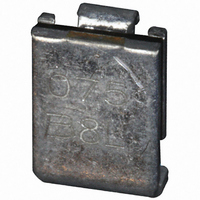MF-SM075/60-2 Bourns Inc., MF-SM075/60-2 Datasheet - Page 3

MF-SM075/60-2
Manufacturer Part Number
MF-SM075/60-2
Description
FUSE PTC RESETTABLE 0.75A HOLD
Manufacturer
Bourns Inc.
Series
MF-SMr
Datasheet
1.MF-SM07560-2.pdf
(12 pages)
Specifications of MF-SM075/60-2
R Min/max
0.230 ~ 1.000 Ohm
Voltage - Max
60V
Time To Trip
0.3s
Current - Hold (ih) (max)
750mA
Current - Trip (it)
1.5A
Current - Max
10A
Package / Case
Non-Standard SMD
Holding Current
750mA
Tripping Current
1.5A
Initial Resistance Max
1ohm
Operating Voltage
60V
Ptc Fuse Case
SMD
Initial Resistance Min
0.23ohm
Length/height, External
3.18mm
External Width
6.73mm
Voltage Rating Vdc
60VDC
Operating Temperature Max
85°C
External Depth
5.44mm
Rohs Compliant
Yes
Lead Free Status / RoHS Status
Lead free / RoHS Compliant
Lead Free Status / RoHS Status
Lead free / RoHS Compliant
Available stocks
Company
Part Number
Manufacturer
Quantity
Price
Company:
Part Number:
MF-SM075/60-2
Manufacturer:
BOURNS
Quantity:
66 000
Company:
Part Number:
MF-SM075/60-2-99
Manufacturer:
BOURNS
Quantity:
66 000
Resettable fuses are manufactured in the form of a conductive plastic, which is comprised of a non-
conductive crystalline polymer with highly conductive carbon black particles impregnated throughout
the crystal lattice. Because of the close proximity of the carbon black particles within the crystal lattice,
under normal conditions current is allowed to flow easily through the conductive plastic. However
under a fault condition, when there is an increase in current, the conductive plastic heats at the rate of
I 2 R. As the material continues to heat, it eventually reaches the phase transformation temperature, which
changes the crystal structure into an amorphous structure. Once the material has transformed into this
amorphous structure, the conductive particles become isolated and are unable to conduct current hence
the drastic change in material resistance. It is only when the current is removed that the material is
allowed to cool and return to its original crystal structure.
It is the materials used in resettable fuses that allow
them to reset after a fault condition has been
removed. Resettable fuses exhibit a positive
temperature coefficient effect when heated. While
many materials exhibit a PTC effect when heated
(an increase in resistance in response to a positive
change in temperature), what makes the material
used in resettable fuses unique is the fact that the
increase in resistance changes exponentially rather
than in a linear manner.
Multifuse® Products – How They Work
Multifuse® Products – How They Are Used
PTC Response Characteristic
I=V/R L
Temperature
PTC Response Characteristic
I=V/R MF
I=V/R L
Temperature
I=V/R MF
Crystalline
Polymer
V S
c o l d
It is because of this transformation from a low
resistance state to a high resistance state that allows
the resettable fuse to protect loads. It is this
transition from the low resistance state to high
resistance state that is referred to as tripping. The
time it takes for a resettable fuse to trip is relatively
quick, depending on how high the fault current is
and it can be as quick as a fraction of a second.
Hence they are an excellent form of protection for
most applications where sensitive devices need
extra protection.
3
Typical Circuit Application
I
Carbon Chains
V S
Conducting
Typical Circuit Application
+t°
I
Amorphous
R MF
Polymer
+t°
h o t
R L
R MF
Non-conducting
Carbon Chains
R L






















